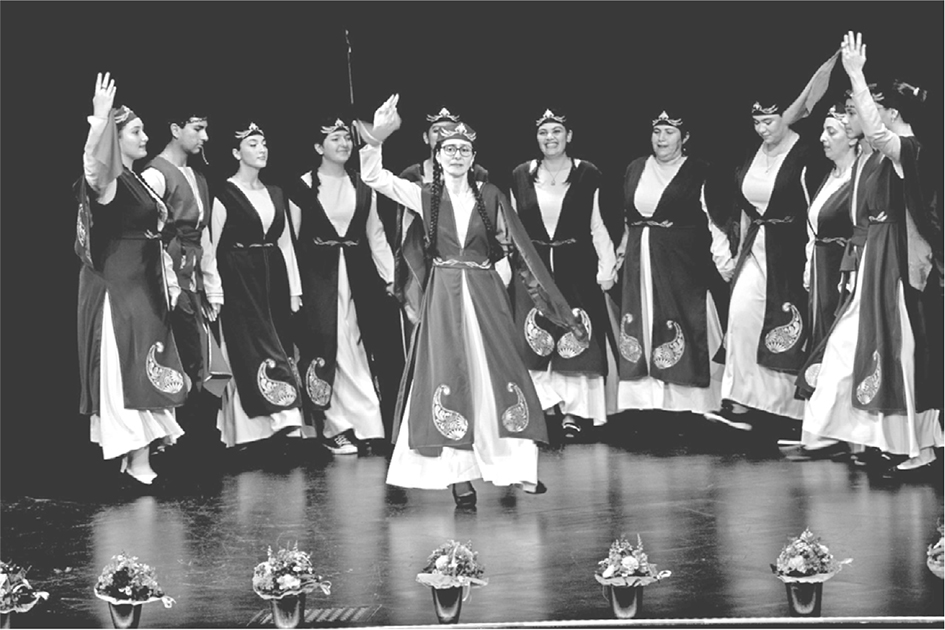
Shushan Tumanyan and the AKV Dance Group
Armenian Community Promotes Unity In Diversity
by Muriel Mirak-Weissbach
the Armenian Mirror Spectator
HESSE, Germany — On September 7, the Armenian Cultural Association (AKV) in Hesse proudly celebrated its 55th jubilee, one of the oldest immigrant communities in the state. While presenting various facets of the uniqueness of Armenian culture, the festive gathering focused on the integrative function of cultural exchange. The event was entitled, “55 Years of Culture, Integration, and Language Diversity.”
In his greetings, Uwe Becker, State Secretary in the Hesse Finance Ministry, made the point most clearly: integration of an ethnic community into German society does not mean relinquishing that identity, but rather, making its own contribution to enrich the culture of what was originally a host country for our ancestors. Becker, who spoke as the representative of the Hesse State Governor, stressed that the city of Frankfurt is rich, not because it is the business and financial capital of the state, but because of the wealth of cultural interchange and dialogue among its diversified population. Of the many contributions made by the Armenian community, he highlighted its music, as well as its cuisine—both abundantly on exhibit during the event. And he noted the importance of the city’s historic St. Paul’s cathedral, which hosts a major commemoration ceremony every year on April 24 for the victims of the Armenian genocide. Becker emphasized the importance of speaking out against genocide denial through such events, as well as in school curricula.
Official greetings came from Armin Preuss, chairman of the Board of the AKV, and Armenuhi Tadevosyan, attaché of the Armenian Embassy in Berlin, before a concert featuring young musicians from the community began.
Arevik Beglaryan performed an original composition, Haghartsin (2018), on the piano, then accompanied soprano Seda Nahapetyan, who sang two Komitas pieces, the favorite Krunk (Crane) and a delightful Hoy Nazan. Violinist Ostap Shpik followed with Tsirani Tsar (Apricot tree), also by Komitas.
Two more prominent members of the Armenian community offered brief remarks. Jonathan Spangenberg, chairman of the Board of the Central Council of Armenians in Germany (ZAD), said the history of the AKV, now over a half-century old, is an integral part of the history of the city of Frankfurt, just as it is an important chapter in the history of Armenians. In fact, as recounted in a short film shown later, the AKV has built bridges between Armenians living in Germany and German society at large. From the very beginning, AKV members have engaged in volunteer activities nurturing harmonious community relations in the city and region. In addition to its own rich calendar of events, the AKV has taken part in numerous international projects, including the International Festival at the Dominican monastery in Frankfurt on the day of the Ascension of Christ, the Brotherhood Peoples Festival every July in nearby Aschaffenburg, as well as the Intercultural Week in Sulzbach every October.
Rev. Vahridsh Baghdassaryan, representing Bishop Serovpé Isakyanhyan, Primate of the Armenian Apostolic Church in Germany, offered greetings and blessings. He took note of the fact that the day of the celebration, September 7, also marks the anniversary of the 1945 pogroms against the Greek minority in Istanbul, as well as Armenians and Jews. In contrast to this violence, the AKV has engaged in promoting peaceful relations with all communities, which Baghdassaryan praised. Participants rose to join in a prayer he offered, a prayer for peace.
Continuing the concert featuring Armenian musicians performing Armenian music, pianist Diana Sahakyan accompanied Mane Harutyunyan on the duduk to present Artur Grigoryan’s “Hay garunner” (Armenian Spring), and followed up with a duet with violinist Ostap Shpik to play the Armenian folklore piece, “Sirezi yarez taran” (My love has been taken away). Sahakyan then offered two solo works, Arno Babajanyan’s “Vagharshapati pare” (Vagharshapat Dance), and “Shushiki” by Komitas.
A special treat, a surprise for many, came next. Bass-baritone Hovhannes Karapetyan, the talented young opera and lieder singer, arrived recently with his wife in Wiesbaden, where he has been engaged by the Hesse State Theater for the season. (https://www. operabase.com/hovhannes-karapetyan-a2176186/bio/en) Karapetyan, who has a powerful, sonorous voice, displayed his versatility, singing (a cappella) Tagh Harutean (Song on the Ascension of Christ) by 10th century monk Saint Gregory of Narek, then, accompanied by pianist Sona Talian, Hayastan (Armenia) by Komitas. His program in Wiesbaden this season includes opera roles, in Beethoven’s “Fidelio” and Rossini’s “Barber of Seville,” as well as lieder. Sona Talian, who is also a composer, closed the concert with solo works.
Art, Dance, and Fine Cuisine As if to illustrate Secretary Becker’s praise of Armenian specialties, the AKV hosted an art exhibit with works by artists Anna Mikayelyan, on the theme of “Meditation,” and Denis Alt with works on “Unknown Armenian Women” and “Armenian Architecture in Istanbul.” Sculptor and art teacher Ishkhan Nazaryan displayed sculptures on the theme “Homeland.” Guests followed from the exhibit area into the adjacent hall, where the long table featured Armenian delicacies and Armenian wines.
To conclude the festive afternoon, Shushan Tumanyan, co-chair of the AKV board and the person chiefly responsible for the massive organizing effort behind the event, took to the stage. Holding her right hand high, with colorful scarf, she led her Armenian dance group, dressed in characteristic attire, in a series of lively dances, then invited all interested attendants to join on stage for an impromptu workshop. Soon, there would be more people on stage than in the hall.